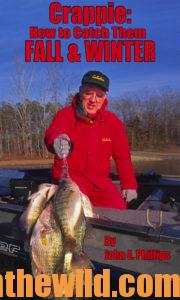Editor’s Note: One of the things I enjoy the most about spring is Friday night fish fries with friends and family. But hey, we don’t have to wait until spring. Plenty of good crappie are available to be caught right now and throughout the winter months.
 “I primarily fish Lake Kincaid in southern Illinois just west of Carbondale,” Kyle Schoenherr of Oakdale, Illinois, explains. “This lake has a lot of deep ledges, it’s very clear, and it has numbers of rock bluffs. During the winter months, I’ve caught crappie before as deep as 58 feet in this lake.
“I primarily fish Lake Kincaid in southern Illinois just west of Carbondale,” Kyle Schoenherr of Oakdale, Illinois, explains. “This lake has a lot of deep ledges, it’s very clear, and it has numbers of rock bluffs. During the winter months, I’ve caught crappie before as deep as 58 feet in this lake.
“To catch these crappie, I use a bottom-bumping rig. I tie a 1/4- or a 1/2-ounce bank sinker to the end of monofilament line. Then, I’ll move up the line about 10 inches and tie a loop in the main line to make the loop stand out about 3 or 4 inches from the main line. I use a single No. 2 Tru-Turn hook (www.ttiblakemore.com) and attach a 2- to 3-inch live minnow to the hook. Once the sinker hits the bottom, I’ll tighten up the line. Generally a crappie already will be on the hook.
“When the sinker hits the bottom, the minnow usually will flutter, attracting crappie and causing them to attack the minnow. But if I don’t have a fish on when I tighten up the line, I’ll jerk the sinker out of the bottom’s mud. Often then, the crappie will attack. Even during the colder months, the crappie are fairly aggressive.”
 As the water temperature becomes colder, the crappie in these deep, clear lakes usually will move down to the 40- or 50-foot deep water or even hold so tight to the bottom that their stomachs will be lying on the mud. Schoenherr spots the individual crappie on the bottom with his Lowrance HDS-10 depth finder (www.lowrance.com) on the console of his boat or his HDS-12 Touch on the back of his boat. When he’s looking for crappie, he sets his side-imaging depth finder on down imaging to get a better and a clearer picture of the individual crappie holding on the bottom.
As the water temperature becomes colder, the crappie in these deep, clear lakes usually will move down to the 40- or 50-foot deep water or even hold so tight to the bottom that their stomachs will be lying on the mud. Schoenherr spots the individual crappie on the bottom with his Lowrance HDS-10 depth finder (www.lowrance.com) on the console of his boat or his HDS-12 Touch on the back of his boat. When he’s looking for crappie, he sets his side-imaging depth finder on down imaging to get a better and a clearer picture of the individual crappie holding on the bottom.
“If I’m looking for structure in the lake – like logs, stumps, stake beds or brush – I’ll run my depth finder in the side-imaging mode,” Schoenherr says.
In the spring, crappie fishermen usually look for vertical structure coming up off the bottom to locate crappie. But during the colder months, Schoenherr pinpoints more crappie holding on low structure along the bottom or on the edges of drop-offs.
“I use 12- to 14-pound test monofilament line from the sinker to about a foot to 18-inches above the hook,” Schoenherr reports. “I tie the monofilament line to  15-pound test braided line that has the diameter of 4-pound test line and prefer a 12-foot graphite rod. The size and numbers of the crappie we catch in the winter surprise many people. Our crappie at this time of the year will weigh from 3/4- up to about 3 pounds.”
15-pound test braided line that has the diameter of 4-pound test line and prefer a 12-foot graphite rod. The size and numbers of the crappie we catch in the winter surprise many people. Our crappie at this time of the year will weigh from 3/4- up to about 3 pounds.”
Lake Kincaid not only has white crappie and black crappie, it also homes a hybrid cross between the two that may weigh from 3 to 4 pounds, since they grow really big. The hybrids are shaped like white crappie and have their vertical barring but sport seven dorsal spines and a speckled pattern like black crappie.
On an average day of wintertime crappie fishing, Schoenherr generally will keep 20 to 30 crappie, and often he and his customers will catch and release at least that many more. The average fish will weigh about 1-1/4-pounds in cold weather. The biggest crappie he’s boated from Lake Kincaid weighed 3.02 pounds. When the surface temperature of the water is in the low 40 degrees, Schoenherr says that’s when the crappie fishing gets good.
For more information on fishing deep water in cold weather for crappie, contact Kyle Schoenherr at www.allseasonscrappiefishing.com.

 For more tips and information on catching crappie, check out John E. Phillips’ Kindle and print books “Crappie: How to Catch Them Fall and Winter” and “Crappie: How to Catch Them Spring and Summer,” or go to http://www.amazon.com/John-E.-Phillips/e/B001HP7K6O to see all of John’s books. To receive and download for free “The Crappie Catchers’ Cookbook,” by John and Denise Phillips, go to https://www.dropbox.com/sh/1tvp5nmxp8jycjf/AAAiOTM6vHolzGV44kO2oEnKa?dl=0.
For more tips and information on catching crappie, check out John E. Phillips’ Kindle and print books “Crappie: How to Catch Them Fall and Winter” and “Crappie: How to Catch Them Spring and Summer,” or go to http://www.amazon.com/John-E.-Phillips/e/B001HP7K6O to see all of John’s books. To receive and download for free “The Crappie Catchers’ Cookbook,” by John and Denise Phillips, go to https://www.dropbox.com/sh/1tvp5nmxp8jycjf/AAAiOTM6vHolzGV44kO2oEnKa?dl=0.










